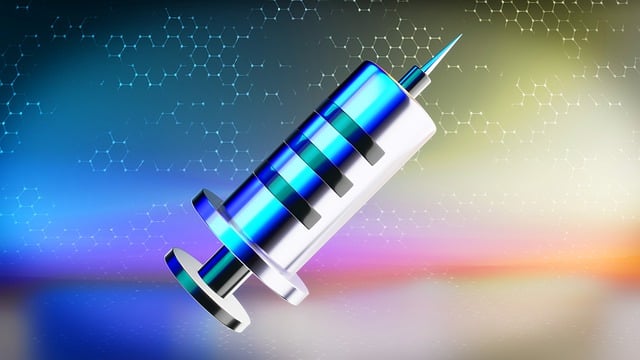Semaglutide, a groundbreaking GLP-1 receptor agonist, transforms diabetes management by mimicking natural hormone actions, stimulating insulin production and suppressing glucagon release. Its once-weekly administration schedule alleviates patient burden, improving quality of life. Clinical trials demonstrate its significant glycemic control benefits for type 2 diabetics, with real-world evidence supporting its safety and effectiveness. Future prospects include personalized medicine approaches through tailored delivery systems and enhanced understanding of its mechanism of action to improve outcomes further. Semaglutide emerges as a powerful semaglutide diabetes treatment, promising advancements in managing this chronic condition.
Semaglutide, a groundbreaking Glucagon-Like Peptide-1 (GLP-1) receptor agonist, has emerged as a powerful tool in diabetes management. With its ability to lower blood sugar levels and promote weight loss, semaglutide diabetes treatment is transforming the lives of those with type 2 diabetes. This article explores the latest innovations in semaglutide formulations, delving into current treatment options, their limitations, and the groundbreaking rise of semaglutide delivery systems. We discuss clinical trials, real-world evidence, and look ahead to personalized medicine and ongoing research.
Understanding Semaglutide: A Glucagon-Like Peptide-1 Receptor Agonist

Semaglutide, a groundbreaking medication, has transformed the landscape of diabetes management. It operates as a Glucagon-Like Peptide-1 (GLP-1) receptor agonist, mimicking the actions of the natural hormone GLP-1 in the body. By activating these receptors, semaglutide stimulates insulin production and suppresses glucagon secretion, leading to improved blood sugar control. This dual effect is particularly beneficial for individuals with type 2 diabetes who often struggle with both elevated insulin resistance and inadequate insulin release.
As a result of its unique mechanism, semaglutide has emerged as a powerful tool in the fight against diabetes. It offers significant advantages over traditional insulin therapies, including once-daily administration and reduced risk of hypoglycemia. These attributes make semaglutide an attractive option for many patients, contributing to improved quality of life and overall diabetes management.
Current Diabetes Treatment Options and Their Limitations

Diabetes management has evolved over the years, with various treatments aimed at regulating blood sugar levels. Traditional options include insulin therapy, oral hypoglycemic agents, and non-insulin injectables like GLP-1 receptor agonists. While these treatments have shown effectiveness, they often come with challenges. Insulin can cause low blood sugar episodes, and oral medications may not be as efficient for all patients, leading to variable results.
Semaglutide, a gut hormone-like peptide (GLP)-1 receptor agonist, has emerged as a game-changer in diabetes treatment. Its formulation offers several advantages over conventional methods. By mimicking the effects of natural GLP-1, semaglutide promotes insulin secretion and suppresses glucagon release, leading to improved glycemic control. Moreover, its once-weekly administration reduces the burden of daily injections, enhancing patient adherence and quality of life.
The Rise of Semaglutide Formulations: Enhancing Diabetes Management

The rise of semaglutide formulations marks a significant advancement in diabetes management, offering a game-changing approach to treating this chronic condition. Semaglutide, a glucagon-like peptide-1 (GLP-1) receptor agonist, has gained traction as an effective and versatile diabetes treatment option. Its unique properties allow for improved glycemic control, making it a valuable addition to the arsenal of tools for healthcare professionals.
These formulations provide a more convenient and potentially more effective way to manage blood sugar levels. By mimicking the actions of natural GLP-1, semaglutide helps stimulate insulin production and suppress glucagon release, leading to better glucose management. The development of various semaglutide delivery methods, including injections and oral medications, has made this treatment more accessible and user-friendly for patients with diabetes.
Key Innovations in Semaglutide Delivery Systems

The field of diabetes management has witnessed significant advancements with the introduction of novel semaglutide formulations. These innovations in delivery systems aim to enhance patient convenience and adherence while optimizing therapeutic outcomes for semaglutide diabetes treatment. One of the key breakthroughs is the development of injectable semaglutide solutions, which offer a more user-friendly alternative to traditional injections. These formulations are designed to improve drug stability and precision dosing, allowing patients to self-administer their medication comfortably at home.
Furthermore, researchers have explored diverse delivery methods, such as oral tablets and inhalers, for semaglutide diabetes treatment. Oral administration has the potential to simplify patient routines by eliminating the need for injections altogether. Similarly, inhaler devices provide a rapid and discreet way of delivering semaglutide, making it more accessible for patients who may struggle with injection techniques or have specific preferences. These innovations continue to shape the future of diabetes care, promising improved quality of life for individuals living with this chronic condition.
Clinical Trials and Real-World Evidence: Efficacy and Safety Profile

Clinical trials have played a pivotal role in establishing the efficacy and safety of semaglutide as a diabetes treatment. These studies have demonstrated that semaglutide can significantly reduce HbA1c levels, providing a substantial benefit for patients with type 2 diabetes. The real-world evidence further reinforces these findings, showing that semaglutide formulations are well-tolerated and effective in diverse patient populations.
The safety profile of semaglutide is characterized by common side effects such as nausea and vomiting, particularly during the initial dosing period. However, these symptoms often diminish over time. More seriously, cases of pancreatitis and kidney issues have been reported, though they are relatively rare. Overall, clinical trials and real-world evidence suggest that semaglutide offers a safe and effective alternative for managing diabetes, promising improved glycemic control alongside a manageable side effect profile.
Future Perspectives: Personalized Medicine and Ongoing Research

The future of semaglutide in diabetes management looks promising, with a growing focus on personalized medicine. Ongoing research aims to refine dosage and administration methods, tailoring treatments to individual patient needs. This includes exploring diverse delivery systems, such as oral formulations or even more advanced technologies like transdermal patches, to improve convenience and adherence. Furthermore, studying semaglutide’s mechanism of action at a deeper level could lead to the development of novel drug candidates with enhanced efficacy and reduced side effects.
Personalized medicine approaches consider genetic variations and patient lifestyle factors to optimize diabetes treatment outcomes. As our understanding of these complexities grows, we can expect more precise and effective semaglutide-based regimens, potentially reducing long-term complications associated with the condition. Such advancements hold the key to improving quality of life for individuals living with diabetes.
